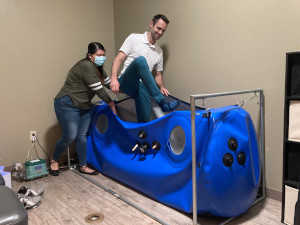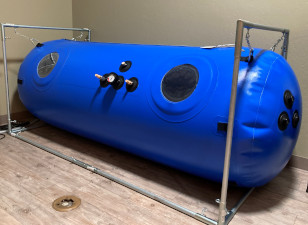
Chiropractor Chandler AZ
Peripheral Neuropathy and Hyperbaric Oxygen Therapy
Peripheral neuropathy is a chronic neurological disorder that affects 20 million people in the United States alone (NIH, n.d.). The peripheral nervous system connects the central nervous system (CNS) consisting of the brain and spinal cord to the peripheral nervous system throughout the rest of the body, allowing sensors to send messages to the brain and the brain to activate appropriate responses such as movement. In a neuropathy, this signalling system is disrupted, typically starting with the longest nerves first (NIH, n.d.). This is why most patients initially feel symptoms in their feet or occasionally in their hands.

Causes of peripheral neuropathy include vascular problems, reactions to chemotherapy and poorly controlled diabetes (NIH, n.d.). Peripheral neuropathy tends to be chronic, meaning it cannot be cured but the symptoms can be managed. While some patients respond well to pharmacological therapies, many do not. Because its symptoms including severe pain and numbness drastically impact a person’s physical function, increase risks of falling and disrupt sleep, it is important that any person affected with this condition be able to find effective treatment options.
For those who are not helped by prescription drugs, alternatives include class IV cold laser and hyperbaric oxygen therapy: both non-invasive, comfortable treatments that can take place in an outpatient setting.
What is hyperbaric oxygen therapy?
Hyperbaric oxygen therapy has been in existence for decades: first developed to treat decompression sickness among deep sea divers, as well as carbon monoxide poisoning. The concept is simple: the patient breathes pure oxygen in a chamber pressurized above sea level atmosphere (1 ATA or 14.7 psi). The combination of oxygen concentration that is five times that of the air we breathe and pressurization enables more oxygen to enter the bloodstream where it exerts therapeutic effects.
To understand how hyperbaric oxygen therapy improves symptoms of peripheral neuropathy, one needs to look “under the microscope,” and understand how this disease process occurs at a molecular level. Preclinical studies by Lim and colleagues have confirmed that ischemia or lack of oxygen drives vascular dysfunction, fibrosis and increased metabolic requirements in the injured nerves (Lim et al., 2015). Most people are aware that oxygen is essential to life processes: a primary function of the circulatory system is to deliver oxygen to various tissues and organs throughout the human body. When starved for oxygen, vital organs including the heart and brain, are starved for oxygen, they are severely damaged or die.

Oxygen is also therapeutic. In the case of peripheral neuropathy, hyperbaric oxygen treatments that vastly increase oxygen concentrations in the blood can help to reverse some of the pathological processes described above. The oxygen reverses microvascular changes prevent blood (and the oxygen it carries) from effectively reaching the nerves; it enables metabolites that feed the nerves to be processed aerobically (efficient) as opposed to anaerobically (not efficient) and it reverses a tendency for the capillaries that supply injured nerves to thicken and become stiff, interfering with the influx of nutrients and oxygen, and outflux of waste (Lin et al., 2015). Scientists believe that the hypoxia caused by peripheral neuropathy blocks the transport of signalling molecules in and out of the nerve cells. This makes the nerves hypersensitive, resulting in pain and numbness (Lin et al., 2015).
Hyperbaric oxygen therapy also enhances autophagy flux: the process by which nerve cells get rid of waste (Liu et al., 2017). It does this by inhibiting the mTOR pathway. mTOR, which stands for “mechanistic target of rapamycin,” is a chemical that controls the homeostatic balance of nutrient delivery and waste disposal in the body. By inhibiting the pathway, hyperbaric oxygen therapy enables the damaged nerve cells to scavenge waste more effectively, decreasing neuropathic pain (Liu et al., 2017).
Hyperbaric oxygen therapy treatment
Most outpatient hyperbaric oxygen therapy treatment takes place in monoplace chambers that hold a single individual: this in contrast to the larger, room-size “multiplace”chambers seen in tertiary facilities such as hospitals(Schafer, 1992). The typical treatment takes about 90 minutes: 15 minutes to pressurize and depressurize the chamber before and after treatment, and 60 minutes for the treatment itself. Similar to being on an airplane during take-off and landing, this pressurizing and depressurizing process can create pressure inside the ear canals, so patients are instructed as to how to clear their ears. Persons experiencing sinus or ear problems should ask their provider about rescheduling the session.
The machine makes some noise, but most individuals feel comfortable reading and relaxing once inside the chamber. An intercom system enables the patient to communicate with providers outside the chamber. Hyperbaric oxygen therapy sessions lasting up to two hours at pressures up to three atmospheres are considered safe and effective (Tobbles & Edelsberg, 1996).
References
Lim, T. et al. (2015). Peripheral nerve injury induces persistent vascular dysfunction and endoneurial hypoxia, contributing to the genesis of neuropathic pain. The Journal of Neuroscience, 35(8), 3346-3359. https://doi.org/10.1523/JNEUROSCI.4040-14.2015
Liu, Y. et al. (2017). Hyperbaric oxygen treatment attenuates neuropathic pain by elevating autophagy flux via inhibiting mTOR pathway. American Journal of Translational Research, 9(5), 2629-2638. http://www.ajtr.org
NIH (n.d.) Peripheral neuropathy fact sheet. National Institute of Neurological Disorders and Stroke. https://www.ninds.nih.gov/Disorders/Patient-Caregiver-Education/Fact-Sheets/Peripheral-Neuropathy-Fact-Sheet
Schaefer, S. (1992). Fundamentals of hyperbaric oxygen therapy. Orthopaedic Nursing, 11(6), 9-15.
Tibbles, P. & Edelsberg, J. (1996). Hyperbaric oxygen therapy. New England Journal of Medicine, 334(5), 1642-1648.